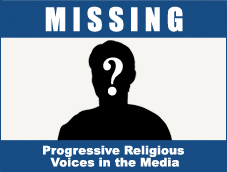LEFT BEHIND: The Skewed Representation of Religion in Major News Media
source
LEFT BEHIND:
The Skewed Representation of Religion in Major News Media
It would surprise few people, conservative or progressive, to learn that coverage of the intersection of religion and politics tends to oversimplify both. If this oversimplification occurred to the benefit or detriment of neither side of the political divide, then the weaknesses in coverage of religion would be of only academic interest. But as this study documents, coverage of religion not only overrepresents some voices and underrepresents others, it does so in a way that is consistently advantageous to conservatives.
As in many areas, the decisions journalists make when deciding which voices to include in their stories have serious consequences. What is the picture of religious opinion? Who is a religious leader? Whose views represent important groups of believers? Every time a journalist writes a story, he or she answers these questions by deciding whom to quote and how to characterize their views.
Religion is often depicted in the news media as a politically divisive force, with two sides roughly paralleling the broader political divide: On one side are cultural conservatives who ground their political values in religious beliefs; and on the other side are secular liberals, who have opted out of debates that center on religion-based values. The truth, however is far different: close to 90 percent of Americans today self-identify as religious, while only 22 percent belong to traditionalist sects. Yet in the cultural war depicted by news media as existing across religious lines, centrist and progressive voices are marginalized or absent altogether.
In order to begin to assess how the news media paint the picture of religion in America today, this study measured the extent to which religious leaders, both conservative and progressive, are quoted, mentioned, and interviewed in the news media.
Among the study's key findings:
- Combining newspapers and television, conservative religious leaders were quoted, mentioned, or interviewed in news stories 2.8 times as often as were progressive religious leaders.
- On television news -- the three major television networks, the three major cable news channels, and PBS -- conservative religious leaders were quoted, mentioned, or interviewed almost 3.8 times as often as progressive leaders.
-
In major newspapers, conservative religious leaders were quoted, mentioned, or interviewed 2.7 times as often as progressive leaders.
Despite the fact most religious Americans are moderate or progressive, in the news media it is overwhelmingly conservative leaders who are presented as the voice of religion. This represents a particularly meaningful distortion since progressive religious leaders tend to focus on different issues and offer an entirely different perspective than their conservative counterparts.











No comments:
Post a Comment